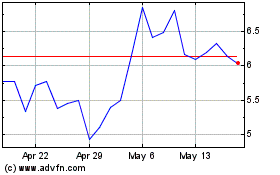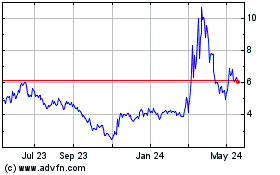- LP-184 is a novel, synthetically-lethal, small molecule that
has been developed using insights from Lantern’s AI platform,
RADR®.
- The first-in-human Phase 1A clinical trial has been cleared to
proceed by the FDA and is anticipated to launch this summer for
multiple advanced solid tumors and brain and central nervous system
(CNS) cancers.
- Lantern has been granted multiple Orphan Drug Designations by
the FDA for LP-184 in pancreatic cancer, malignant gliomas, and
atypical teratoid rhabdoid tumors (ATRT); in addition the FDA
granted Rare Pediatric Disease Designation granted for LP-184 in
ATRT.
- The cancer indications being pursued for LP-184 are estimated
to have an annual market potential of $11-13 billion; $6-7 billion
for solid tumors and $5-6 billion for brain and CNS cancers.
Lantern Pharma Inc. (NASDAQ: LTRN), an artificial intelligence
("AI") company developing targeted and transformative cancer
therapies using its proprietary RADR® AI and machine learning
(“ML”) platform with multiple clinical stage drug programs, today
announced that the U.S. Food and Drug Administration (FDA) has
cleared the investigational new drug (IND) application for LP-184,
which is being developed for multiple advanced solid tumors and
central nervous system (CNS) cancers. The first-in-human Phase 1A
trial for LP-184 is anticipated to launch and dose its first
patient during the current quarter.
“The clearance of the IND application is a significant milestone
for our LP-184 program and validates our approach of leveraging AI
and machine learning to advance our pipeline of novel drug
candidates,” stated Panna Sharma, Lantern’s CEO and President.
“Insights from our AI platform RADR® were instrumental in our
development of LP-184 and aided in discovering its mechanism of
action, identifying and prioritizing its cancer indications, and
generating machine learning biomarker signatures to assist with
future clinical trial patient selection. We believe LP-184 has
blockbuster potential for patients with multiple types of advanced
solid tumors and CNS cancers, many of which have no or limited
effective therapeutic options,” continued Sharma.
LP-184 is the first of Lantern’s drug candidates to be developed
entirely internally, with the assistance of Lantern’s AI and ML
platform RADR®, to advance to a first-in-human Phase 1A trial. The
Phase 1A trial will assess the safety and tolerability of
escalating doses of LP-184 to determine the maximum tolerated dose
(MTD) in patients with advanced pancreatic cancer, recurrent
high-grade gliomas/glioblastoma (GBM), metastatic brain and CNS
cancers, and other solid tumors with DNA damage response (DDR)
deficiencies. Lantern anticipates the Phase 1A trial to be
completed by the first half of 2024.
After the Phase 1A trial is completed, Lantern will advance
LP-184 into additional clinical trials for multiple solid tumor
indications, and Lantern’s subsidiary, Starlight Therapeutics, will
advance the clinical development of LP-184 for all brain and CNS
indications under the name STAR-001. Globally, the aggregate annual
market potential of LP-184/STAR-001’s programs is estimated to be
approximately $11-13 billion, consisting of $6-7 billion for solid
tumors and $5-6 billion for CNS cancers.
About LP-184:
LP-184 is a unique small molecule that utilizes its powerful
mechanism of action known as synthetic lethality to exploit common
vulnerabilities in solid tumor and CNS cancers with DNA damage
repair (DDR) deficiencies. The anti-tumor potential of LP-184 has
been demonstrated across an extensive number of in-vitro and
in-vivo cancer models, including pancreatic, bladder,
triple-negative breast cancer (TNBC), glioblastoma (GBM), brain
metastases, and ATRT. In addition to LP-184’s promise as a single
agent, its antitumor potency has the potential to be enhanced when
used in combination with existing FDA-approved agents and other
treatment modalities including spironolactone, PARP inhibitors, and
radiation therapy. Results validating LP-184’s anti-tumor potential
have been published at leading conferences and journals including,
the American Association for Cancer Research annual meeting, the
Society for Neuro-Oncology annual meeting, the San Antonio Breast
Cancer Symposium, and the Frontiers in Drug Discovery Journal.
About Lantern Pharma:
Lantern Pharma is an AI company transforming the cost, pace, and
timeline of oncology drug discovery and development. Our
proprietary AI and machine learning (ML) platform, RADR®, leverages
over 25 billion oncology-focused data points and a library of 200+
advanced ML algorithms to help solve billion-dollar, real-world
problems in oncology drug development. By harnessing the power of
AI and with input from world-class scientific advisors and
collaborators, we have accelerated the development of our growing
pipeline of therapies including eleven cancer indications and an
antibody-drug conjugate (ADC) program. On average, our newly
developed drug programs have been advanced from initial AI insights
to first-in-human clinical trials in 2-3 years and at approximately
$1.0-2.0 million per program.
Our lead development programs include two Phase 2 clinical
programs and multiple upcoming Phase 1 clinical trials anticipated
for 2023. We have also established a wholly-owned subsidiary,
Starlight Therapeutics Inc., to focus exclusively on the clinical
execution of our promising therapies for CNS and brain cancers,
many of which have no effective treatment options. Our AI-driven
pipeline of innovative product candidates is estimated to have a
combined annual market potential of over $15 billion USD and have
the potential to provide life-changing therapies to hundreds of
thousands of cancer patients across the world.
Please find more information at: Website: www.lanternpharma.com
LinkedIn: https://www.linkedin.com/company/lanternpharma/ Twitter:
@lanternpharma Lantern Pharma Newsletter – The Spark: Sign-up
here
Forward-looking Statements:
This press release contains forward-looking statements within
the meaning of Section 27A of the Securities Act of 1933, as
amended, and Section 21E of the Securities Exchange Act of 1934, as
amended. These forward-looking statements include, among other
things, statements relating to: future events or our future
financial performance; the potential advantages of our RADR®
platform in identifying drug candidates and patient populations
that are likely to respond to a drug candidate; our strategic plans
to advance the development of our drug candidates and antibody drug
conjugate (ADC) development program; estimates regarding the
development timing for our drug candidates and ADC development
program; expectations and estimates regarding clinical trial timing
and patient enrollment; our research and development efforts of our
drug discovery and ADC programs and the utilization of our RADR®
platform to streamline the drug development process; our intention
to leverage artificial intelligence, machine learning and genomic
data to streamline and transform the pace, risk and cost of
oncology drug discovery and development and to identify patient
populations that would likely respond to a drug or ADC candidate;
estimates regarding patient populations, potential markets and
potential market sizes; sales estimates for our drug and ADC
candidates and our plans to discover and develop drug and ADC
candidates and to maximize their commercial potential by advancing
such candidates ourselves or in collaboration with others. Any
statements that are not statements of historical fact (including,
without limitation, statements that use words such as "anticipate,"
"believe," "contemplate," "could," "estimate," "expect," "intend,"
"seek," "may," "might," "plan," "potential," "predict," "project,"
"target," "model," "objective," "aim," "upcoming," "should,"
"will," "would," or the negative of these words or other similar
expressions) should be considered forward-looking statements. There
are a number of important factors that could cause our actual
results to differ materially from those indicated by the
forward-looking statements, such as (i) the impact of the COVID-19
pandemic, (ii) the risk that our research and the research of our
collaborators may not be successful, (iii) the risk that none of
our product candidates has received FDA marketing approval, and we
may not be able to successfully initiate, conduct, or conclude
clinical testing for or obtain marketing approval for our product
candidates, (iv) the risk that no drug product based on our
proprietary RADR® AI platform has received FDA marketing approval
or otherwise been incorporated into a commercial product, and (v)
those other factors set forth in the Risk Factors section in our
Annual Report on Form 10-K for the year ended December 31, 2022,
filed with the Securities and Exchange Commission on March 20,
2023. You may access our Annual Report on Form 10-K for the year
ended December 31, 2022 under the investor SEC filings tab of our
website at www.lanternpharma.com or on the SEC's website at
www.sec.gov. Given these risks and uncertainties, we can give no
assurances that our forward-looking statements will prove to be
accurate, or that any other results or events projected or
contemplated by our forward-looking statements will in fact occur,
and we caution investors not to place undue reliance on these
statements. All forward-looking statements in this press release
represent our judgment as of the date hereof, and, except as
otherwise required by law, we disclaim any obligation to update any
forward-looking statements to conform the statement to actual
results or changes in our expectations.
View source
version on businesswire.com: https://www.businesswire.com/news/home/20230612954913/en/
Nicole Leber Investor Relations Associate
ir@lanternpharma.com
Lantern Pharma (NASDAQ:LTRN)
Historical Stock Chart
From Jun 2024 to Jul 2024

Lantern Pharma (NASDAQ:LTRN)
Historical Stock Chart
From Jul 2023 to Jul 2024
